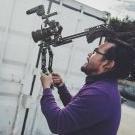
Axel
-
Posts
1,900 -
Joined
-
Last visited
Reputation Activity
-
 Axel got a reaction from Mat Mayer in iMac or specialist editing rig?
Axel got a reaction from Mat Mayer in iMac or specialist editing rig?
@M Carter
Amazing. Of course I am only a wedding videographer who practically never needs to touch an old project. Part of the marriages go sour before I would feel the urge to free disk space. Lucky me.
I wonder why you then don't buy a Pegasus R6 or R8. They are getting faster the bigger they are.
@Mat Mayer
Agreed.
-
 Axel got a reaction from Flynn in Ursa mini...is this the end of blackmagic?
Axel got a reaction from Flynn in Ursa mini...is this the end of blackmagic?
Lousy camera operator. Existential decision. Spent too much time and money and wasn't creative.
The best film is the film that is actually made. And the worst excuse in summer 2016 is that I didn't own the right camera. I always had the right camera. The Ursa Mini would have been the momentary object of my NCD, a more reasonable one perhaps the upcoming GH5.
What I mean is, if a fail with the Pocket, I fail with any other camera. If I succeed with my iPhone, the success would only be gradually better in the end had I had an Alexa instead.
-
 Axel got a reaction from DBounce in Ursa mini...is this the end of blackmagic?
Axel got a reaction from DBounce in Ursa mini...is this the end of blackmagic?
Lousy camera operator. Existential decision. Spent too much time and money and wasn't creative.
The best film is the film that is actually made. And the worst excuse in summer 2016 is that I didn't own the right camera. I always had the right camera. The Ursa Mini would have been the momentary object of my NCD, a more reasonable one perhaps the upcoming GH5.
What I mean is, if a fail with the Pocket, I fail with any other camera. If I succeed with my iPhone, the success would only be gradually better in the end had I had an Alexa instead.
-
 Axel got a reaction from Snowfun in Ursa mini...is this the end of blackmagic?
Axel got a reaction from Snowfun in Ursa mini...is this the end of blackmagic?
I had been listening to people who told me, look, it's not even real HD and UHD is the way to go nowadays. They were right, I saw the Pocket's limits in resolution, and it started to bother me. I sold it and every piece of equipment associated with it. Now I have tons of footage from the said people in glorious 4k and I can watch it in native resolution and I can compare it to my old Pocket footage. And I could cry. Resolution isn't everything. What about handling? People have exact CWB, various implementations of AF, AE or - and this is not exaggerated - millions of combinable profile-settings. None of these has the Pocket. And yet, all these funky functions don't seem to help much, because of the image quality. You don't believe that or see that? Then be happy, stay happy ...
-
 Axel got a reaction from Flynn in Ursa mini...is this the end of blackmagic?
Axel got a reaction from Flynn in Ursa mini...is this the end of blackmagic?
I had been listening to people who told me, look, it's not even real HD and UHD is the way to go nowadays. They were right, I saw the Pocket's limits in resolution, and it started to bother me. I sold it and every piece of equipment associated with it. Now I have tons of footage from the said people in glorious 4k and I can watch it in native resolution and I can compare it to my old Pocket footage. And I could cry. Resolution isn't everything. What about handling? People have exact CWB, various implementations of AF, AE or - and this is not exaggerated - millions of combinable profile-settings. None of these has the Pocket. And yet, all these funky functions don't seem to help much, because of the image quality. You don't believe that or see that? Then be happy, stay happy ...
-
 Axel got a reaction from andrgl in Ursa mini...is this the end of blackmagic?
Axel got a reaction from andrgl in Ursa mini...is this the end of blackmagic?
I had been listening to people who told me, look, it's not even real HD and UHD is the way to go nowadays. They were right, I saw the Pocket's limits in resolution, and it started to bother me. I sold it and every piece of equipment associated with it. Now I have tons of footage from the said people in glorious 4k and I can watch it in native resolution and I can compare it to my old Pocket footage. And I could cry. Resolution isn't everything. What about handling? People have exact CWB, various implementations of AF, AE or - and this is not exaggerated - millions of combinable profile-settings. None of these has the Pocket. And yet, all these funky functions don't seem to help much, because of the image quality. You don't believe that or see that? Then be happy, stay happy ...
-
 Axel reacted to M Carter in iMac or specialist editing rig?
Axel reacted to M Carter in iMac or specialist editing rig?
I think you're misreading what I mean by "Archiving". Sure, original card is in there, and the edit files. And the 1080 and 4K prores versions of everything, the after effects files and renders, the stills, the audio, the protools folder with audio sweetens or repairs or edits or music, all the client notes, storyboards, and edits, the bid, the revises to the bid, the script and revisions, reference images, edits from first pass to final, and Flash or Carrara animations and their associated image sequence folders... I mean, the whole freakin' job, with the entire folder structure preserved.
100-200GB folders are the norm, but I just archived a 1.2 terrabyte job (6 or 7 shoot days, primarily interviews and b-roll, and tons of graphics). I had several brand new 1TB drives, tried like hell to prune that folder down. I generally archive when my 4TB RAID gets over half full, if possible. As I mentioned earlier, this can be 5-10 hours of copying and file managing. Doesn't shut the computer down, just makes it slower, so I try to do it overnight or on a weekend... except I seem to work a lot of weekends...
I just convert everything to ProRes from the start though, render everything from AE as prores (unless I need an alpha channel) and generally do image sequences from other programs and convert those to prores if needed. It takes very little time (I usually do it while I'm checking cameras and gear back in) but saves me a lot of hassle down the road. Disk space is cheap.
-
 Axel got a reaction from Xavier Plagaro Mussard in Davinci resolve qualifier tool
Axel got a reaction from Xavier Plagaro Mussard in Davinci resolve qualifier tool
BTW: I made a mistake, it's serial node, not sequential node.
You seem to have FCP X (other thread). This is way more easy to comprehend and much more intuitive in many respects.
Even correctly exposed and white-balanced clips sometimes don't have very appealing skin tones. Canon and Nikon are often (but not always) better at that than Sony. With optimal A7rii (PP6, sharpness and saturation dialed down, my own preference over S-log) - footage, the skin looked less attractive than possible. I had just loaded the Tiffen DFX plugins as a trial and browsed through them. One filter, called Nude/FX, warms up skin tones. A porn filter if you like. I created a better one in Motion (copying the colorize - filter and reversing the skin-keyer to 'colorize' instead of 'protect'). You have to move the "AXS" folder from downloads to >private >movies >motion templates >effects, then you find it in FCP X's effect browser (it's called "Hautfarben', german for skin color), with preview also.
In FCP X, try to use an adjustment layer, connected above the whole length of the timeline (move titles and graphics above it, so that they aren't influenced). You could ...
a) ... use FCP X's own qualifier ("color mask" in >effects >color >color), select the skin tones *over* ONE clip and correct them. You could also save this corrections as "skin" or so. Don't be too "in-tolerant". No problem, if some wood, "autumn leaves" (name of a Sony creative style, an inside joke, pleasing colors, but not very grading-friendly and suboptimal DR) or cereals are changed as well.
b) ... find a Lut that changes the skin tones (or export your own one using Resolve, but beware: expert level !!!), using LutUtility or Color Finale.
c) ... just apply my crude colorize filter to the adjustment layer.
... many ways to skin a cat.
The concept of the adjustment layer allows easier control over your operations. Needless to say than you can stack them and rename them, blade them and toggle their visibilty with "v" for before & after as well as change blend modes and transparency. You could key your weird colored sky (proof that you made some major mistakes) with FCP X's own excellent keyer and apply a correction on a separate adjustment layer. They are not as good as Resolves nodes, nor is any of those tools nearly as precise as those within Resolve (okay, one, the keyer), but I found out for myself that I never will become a master of colors and that the unbelievable simplicity of FCP X leads to pleasing results very quickly.
-
 Axel got a reaction from Xavier Plagaro Mussard in Davinci resolve qualifier tool
Axel got a reaction from Xavier Plagaro Mussard in Davinci resolve qualifier tool
Nobody answers, because you didn't RTFM.
You have to eventually, but I help you out once:
To perform the same tool with another purpose, you need a new > NODE (manual)
Efficient order of corrections:
1. Node - primary corrections, optimize contrast, get rid of color cast.
The second node (learn about the differences of sequential and parallel nodes) sees the first node as another instance of the image. You perform everything on top of the first.
2, 3 asf.. Node - secondary corrections - you isolate colors with the qualifier or areas with a mask.
Finally you create a look on top of the primary and secondary correction with further nodes.
You can >save the grade
It becomes a still to be compared to ungraded shots with the splitscreen tool, but it can also be dragged&dropped to ungraded clips. If you have done all corrections in meaningful order and understand your own "node tree", you can easily adjust minor differences in exposure asf. in the rest of the shots. No faster and easier method.
-
 Axel got a reaction from kaylee in Davinci resolve qualifier tool
Axel got a reaction from kaylee in Davinci resolve qualifier tool
Nobody answers, because you didn't RTFM.
You have to eventually, but I help you out once:
To perform the same tool with another purpose, you need a new > NODE (manual)
Efficient order of corrections:
1. Node - primary corrections, optimize contrast, get rid of color cast.
The second node (learn about the differences of sequential and parallel nodes) sees the first node as another instance of the image. You perform everything on top of the first.
2, 3 asf.. Node - secondary corrections - you isolate colors with the qualifier or areas with a mask.
Finally you create a look on top of the primary and secondary correction with further nodes.
You can >save the grade
It becomes a still to be compared to ungraded shots with the splitscreen tool, but it can also be dragged&dropped to ungraded clips. If you have done all corrections in meaningful order and understand your own "node tree", you can easily adjust minor differences in exposure asf. in the rest of the shots. No faster and easier method.
-
 Axel got a reaction from Stanley in Best focusing method when shooting with stabilizer
Axel got a reaction from Stanley in Best focusing method when shooting with stabilizer
Better the hyperfocal distance.
With most wide lenses and small apertures, the focus setting wouldn't be infinity but, amazingly, between 3 and 6 feet. According to an online DoF calculator, with a 12mm @f7 on a GH2 it would be 4,4 feet.
-
 Axel got a reaction from mercer in The Anatomy of Story - John Truby
Axel got a reaction from mercer in The Anatomy of Story - John Truby
You are right, of course. It's just that an original, organic story needs to be structured. It needs to be edited, rewritten, polished, trimmed. But the wild and uncensored idea must be first. The content. Even meaning and message come later. Or everything becomes a boring mess.
-
 Axel got a reaction from mercer in The Anatomy of Story - John Truby
Axel got a reaction from mercer in The Anatomy of Story - John Truby
Yes, and we must distinguish between the formal conventions a screenplay has to have to meet the expectations of the professional buyers and things like "the arc of suspense", motivations, narrational economy asf.
The first part is now facilitated by Word and some specialized screenwriting apps (Syd Fields book must me so old, he probably only knew white paper and a typewriter). As for the other stuff, it seems to be a basic truth if you analyze films or novels. Field kind of reverse-engineers the films, counting minutes and pages and how they correspond to the stages of the developing conflicts.
Now what his scholars can do is make check marks at the end of page ten, twenty asf to see if they established the conflict, reached the plot point at the right pace.
If a conventional form is what you are after, you can of course do that, but imo you can NEVER invent something with a rigid structure in the back of the mind. This is simple psychology. If you are obsessed with formal criteria, you will never create something original.
This collective subconscious is what bad films, formalistic genre films, "movies" transport. You have (according to Jung) little worth as a human being if you move with the crowd, avoid painful individuation (a Jungian term) and always choose the blue pill. There are other valuable ideas, like the masks we wear (directors should exploit that with their actors) and our shadow. Stanley Kubrick cited the shadow in his Full Metal Jacket. A film, btw, Syd Field would have had a nice challenge in making the structure fit to his rules ...
-
 Axel reacted to mercer in The Anatomy of Story - John Truby
Axel reacted to mercer in The Anatomy of Story - John Truby
Well said. Syd Field was a little unpopular for awhile because a lot of writers thought his "paradigm" was to formulaic when in reality it was just a basic truth about screenplay structure. There are a million ways to tell a story, but if your screenplay is not structured properly, your narrative will fall apart. Of course, not all screenplays would benefit from that paradigm... Especially short screenplays, but all screenwriters will benefit from understanding structure.
I also recommend reading some Carl Jung, his ideas on the "collective subconscious" and "archetypes" are extremely valuable for a storyteller.
-
 Axel got a reaction from Kurtisso in The Anatomy of Story - John Truby
Axel got a reaction from Kurtisso in The Anatomy of Story - John Truby
Imo, you can read this as primer and closer. Not, because it is so insightful or inspiring, but on the contrary, because it analyzes something that should be quite obvious for someone who wants to learn how to tell a story.
In recent years, it has become hip to refer to The Hero's Journey, deducting the roots for all narrations in mythology. Quite interesting read, but if Syd Fields "findings" actually repeat what Aristotle had found some 2300 years before about the nature of drama (completely with 3 to 5 acts and what have you), these books (i.e. The Hero With A Thousand Faces) don't help to understand story, let alone let you find your own narrational structure.
Reality proof: good stories don't fit those "receipts". Moby Dick, just for instance, would never have been approved by any lector infected by those dogmata.
There is a hereditary need for human beings to tell stories. In the office between colleagues, to your children, around the campfire. They may be personal, educational, reassuring, unsettling asf. But they have to be interesting. The content as well as the form. Someone offers you a formula? Fine, but someone wise once said the form should follow the content. Find something you find worth telling to the world, and the best way to tell it will be revealed to you by your muse.
-
 Axel got a reaction from mercer in The Anatomy of Story - John Truby
Axel got a reaction from mercer in The Anatomy of Story - John Truby
Imo, you can read this as primer and closer. Not, because it is so insightful or inspiring, but on the contrary, because it analyzes something that should be quite obvious for someone who wants to learn how to tell a story.
In recent years, it has become hip to refer to The Hero's Journey, deducting the roots for all narrations in mythology. Quite interesting read, but if Syd Fields "findings" actually repeat what Aristotle had found some 2300 years before about the nature of drama (completely with 3 to 5 acts and what have you), these books (i.e. The Hero With A Thousand Faces) don't help to understand story, let alone let you find your own narrational structure.
Reality proof: good stories don't fit those "receipts". Moby Dick, just for instance, would never have been approved by any lector infected by those dogmata.
There is a hereditary need for human beings to tell stories. In the office between colleagues, to your children, around the campfire. They may be personal, educational, reassuring, unsettling asf. But they have to be interesting. The content as well as the form. Someone offers you a formula? Fine, but someone wise once said the form should follow the content. Find something you find worth telling to the world, and the best way to tell it will be revealed to you by your muse.
-
 Axel got a reaction from kaylee in The Anatomy of Story - John Truby
Axel got a reaction from kaylee in The Anatomy of Story - John Truby
Imo, you can read this as primer and closer. Not, because it is so insightful or inspiring, but on the contrary, because it analyzes something that should be quite obvious for someone who wants to learn how to tell a story.
In recent years, it has become hip to refer to The Hero's Journey, deducting the roots for all narrations in mythology. Quite interesting read, but if Syd Fields "findings" actually repeat what Aristotle had found some 2300 years before about the nature of drama (completely with 3 to 5 acts and what have you), these books (i.e. The Hero With A Thousand Faces) don't help to understand story, let alone let you find your own narrational structure.
Reality proof: good stories don't fit those "receipts". Moby Dick, just for instance, would never have been approved by any lector infected by those dogmata.
There is a hereditary need for human beings to tell stories. In the office between colleagues, to your children, around the campfire. They may be personal, educational, reassuring, unsettling asf. But they have to be interesting. The content as well as the form. Someone offers you a formula? Fine, but someone wise once said the form should follow the content. Find something you find worth telling to the world, and the best way to tell it will be revealed to you by your muse.
-
 Axel reacted to shijan in The simplest BMMCC rig ever made :)
Axel reacted to shijan in The simplest BMMCC rig ever made :)
Just a metal plank with two (or better three) holes with $7 Pistol Grip Handle For Binoculars/Monocular. The handle screwed directly to monitor! Very simple, compact and way better balanced for handled shooting than pistol grip at the bottom. Also angle HDMI adapters helps a lot.
-
 Axel reacted to Liam in The Anatomy of Story - John Truby
Axel reacted to Liam in The Anatomy of Story - John Truby
This might not be the advice you want, but I really like the theory of not learning how to tell a story at all. Learn what others do, sure, like watch as many films as you can, behind the scenes type stuff all day, but mostly just do whatever you want, and then you've got something original. You make it "wrong", and it could be the best thing ever. A lot of great filmmakers have basically given that advice - Robert Rodriguez, Orson Welles - anyway, just a thought. I know a lot of filmmakers know the rules too, so it's not gospel. I'd still suggest a book if I could think of one, sorry, but good luck!
-
 Axel reacted to fuzzynormal in Final Cut pro X vs adobe premiere pro CC
Axel reacted to fuzzynormal in Final Cut pro X vs adobe premiere pro CC
Cutting is cutting. If the handle of the knife feels a bit better than some other, that's cool.
I mean, there was someone on here a year or so ago claiming he edited with After Effects.
Not sure how that's the most productive thing, but if he made it work for him, why not?
Theres a legacy notion among technical/artistic careers that one needs professional gear to make professional product. It's up to the individual to determine if that particular notion makes sense for them or not, based on what current consumer tech offers.
FWIW, I moved off FCP7 to Resolve and Premiere (mostly Premiere at the moment)
-
 Axel reacted to Oliver Daniel in Final Cut pro X vs adobe premiere pro CC
Axel reacted to Oliver Daniel in Final Cut pro X vs adobe premiere pro CC
I personally think FCPX is more advanced and built for the future (compared to PP).
It's rather intuitive, but simplified approach is often mistaken by amazing software development. It's an editor that helps you work faster, better and more fluid. There's more time for creativity, rather than battling error messages and slow responses.
I don't care less what people edit on, however the negativity usually aimed at FCPX is no longer totally justified. It's come on a long, long way and works brilliantly. Early haters should try again.
-
 Axel got a reaction from HelsinkiZim in Final Cut pro X vs adobe premiere pro CC
Axel got a reaction from HelsinkiZim in Final Cut pro X vs adobe premiere pro CC
Something worth thinking about. There really is no 'industry' anymore, at least not if this refers to enterprises which set up blueprints for production pipelines and man them with workers. This industry, audio-visual media, became hell for people who have to work for a living and perhaps plan for a family.
On german video sites, the FCP X haters label the "pros" that use this NLE "trunk producers". I almost became one of them, it's called "Ich AG" (literally: 'Me PLC'; in Germany: person(s) in self-employment as partof a government-funded scheme to help jobless people to start-uptheir own business).
As your own camera operator, sound engineer, driver, editor, colorist and what have you - what do you need Adobe for? You can be creative (Adobes motto) at designing your own funky lower thirds within After Effects? Well, you hardly get paid fairly for that extra effort. There are thousands of free Motion templates that can easily and in no time be adjusted for your needs. A handful of specialized graphic designers, who probably do nothing else, let you use better ones for a reasonable fee. You'd be crazy to sit awake after a long shoot and editing session and try to top those on your own.
So maybe FCP X is for hobbyists and trunk producers, but who cares? I've opened an own thread on the topic. My suspicion is that Adobe would like to become less industry standard and more trunk production suite. But they fear to lose their nimbus.
-
 Axel got a reaction from Orangenz in Turns out people hate being filmed
Axel got a reaction from Orangenz in Turns out people hate being filmed
Do you like to be filmed?
I accept that people feel uneasy when someone holds a camera (or smartphone) to their faces, because I know how impertinent and ignorant that can be.
I feign respect for their privacy and kindly ask for permission. I smile and reassure them nonverbally that they can feel safe. Works in 90% of all cases. The remaining 10%? Well, it's their right to forbid it. Simple as that.
People like to be respected, but they also, in my experience, like to be asked and then directed. It's more about psychology than about personal rights. You've got to have (and show) empathy and then exploit that. Polite words aren't enough, it's your body language and your whole manner.
That's why I still shoot weddings. The lens is their 'magic mirror'.
-
 Axel got a reaction from iamoui in Turns out people hate being filmed
Axel got a reaction from iamoui in Turns out people hate being filmed
Do you like to be filmed?
I accept that people feel uneasy when someone holds a camera (or smartphone) to their faces, because I know how impertinent and ignorant that can be.
I feign respect for their privacy and kindly ask for permission. I smile and reassure them nonverbally that they can feel safe. Works in 90% of all cases. The remaining 10%? Well, it's their right to forbid it. Simple as that.
People like to be respected, but they also, in my experience, like to be asked and then directed. It's more about psychology than about personal rights. You've got to have (and show) empathy and then exploit that. Polite words aren't enough, it's your body language and your whole manner.
That's why I still shoot weddings. The lens is their 'magic mirror'.
-
 Axel got a reaction from mercer in BlackMagic Micro Cinema Update?
Axel got a reaction from mercer in BlackMagic Micro Cinema Update?
Imo there are circumstances where raw can be the better choice. Ed mentioned the mixed color temperatures. This is where every average camera fails and where raw cameras shine. Mixed lighting was seldom used before, but with raw it can give your images that special dynamic and depth that make them stand out.
On the other hand, there are disadvantages too. Depending on the lens used, you will get considerably more moire than with ProRes. This is particularly true for the very sharp Sigma 18-35.
And ProRes LOG ("film"), compared to ordinary 8-bit rec709 ("video") and with the latter as your target, ProRes also gives you a lot of freedom with WB and exposure. Make your own tests. In Resolve, both raw and ProRes mix with no issues.
I don't know your Mac or which other software you use, but if your graphics are too weak (you should have 2GB VRAM) to play back HD CinemaDNG in Resolve in realtime, you can generate ProRes as proxies, either for editing it in Premiere or FCP X or even for Resolve as NLE. A few years ago I used Apples Color, which didn't have RT playback. But for grading, RT isn't mandatory. Not so much as for motion graphics, and AAE users don't have even that these days (this is allegedly going to change now). Otherwise the raw feels like DV in Resolve.








